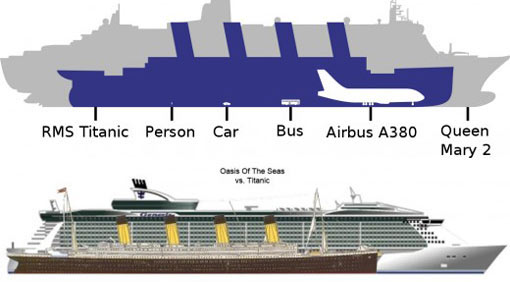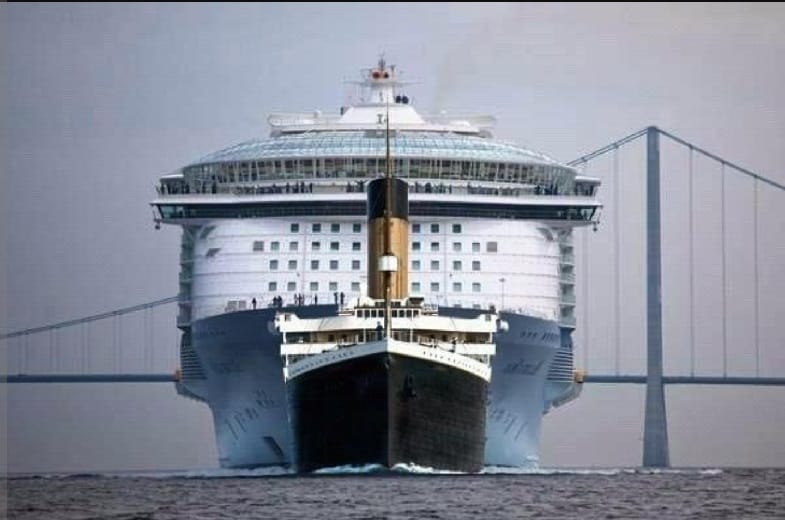Table Of Content

So, while the Titanic was not a cruise ship, it did have many of the features that have since become standard on modern cruise ships. Gone are the days when swimming was only possible during warm weather conditions on a cruise ship. Thanks to innovative designs, some modern cruise ship pools are equipped with retractable roofs or glass enclosures that allow for year-round swimming regardless of the weather outside. Whether it’s pouring rain or chilly winds are blowing, you can still enjoy a leisurely swim in comfort and style while admiring breathtaking ocean views. Offering a variety of options that cater to different age groups and preferences.
Dining and Entertainment
For the world’s biggest cruise ship Wonder of the Seas, capacity actually stands at 6,988 guests, which is more than two and a half times that of the Titanic. When the Titanic set sail on her ill-fated maiden voyage in 1912, she was the largest ship to ever enter service. Designed by Thomas Andrews, the Titanic could hold around 3,300 passengers, cost a staggering £7.5 million to build and was hailed as a feat of engineering. We take a look at the size and scale of the Titanic compared to cruise ship proportions today. But if there ever was a breach on Icon, double hull structures and enhanced watertight compartments could better defend against flooding. The Titanic was famously crewed by over 900 crew members, while a modern cruise ship has significantly more personnel.
You Have Much More to Do on a Modern Cruise Ship
Today’s vessels feature multiple pools, including adults-only areas, water parks with thrilling slides, and even artificial wave simulators for surfing enthusiasts. The design and technology of modern cruise ships have come a long way since the days of the Titanic. Fire incidents at sea can be catastrophic if not handled swiftly and efficiently. Today’s cruises prioritize fire safety through comprehensive protocols aimed at prevention, detection, and suppression. Advanced fire detection systems are installed throughout modern cruise ships, constantly monitoring for any signs of fire. Automatic sprinkler systems and other suppression mechanisms are strategically placed to combat fires effectively.
Titanic vs Modern Cruise Ship Size Comparison Infographic
Icon of the Seas vs Titanic: A Giant Comparison - Cruise Hive
Icon of the Seas vs Titanic: A Giant Comparison.
Posted: Mon, 19 Feb 2024 08:00:00 GMT [source]
Beyond the sinking of the Titanic, it also lost the HMHS Britannic and the Republic, all in a 10-year period. In comparison, Royal Caribbean’s Symphony of the Seas is equipped with 18 lifeboats that are able to fit 370-people each, or enough for 6,660 people. As such, the Titanic’s cabins and common spaces were decked out with elegant European-style decor, with sweeping staircases (yes, including the one from the movie), ornate woodwork and luxurious furnishings.
What is the biggest difference between the Titanic and modern cruise ships?
World’s biggest cruise ship 5 times the size of the Titanic and even has it's own beach - Express
World’s biggest cruise ship 5 times the size of the Titanic and even has it's own beach.
Posted: Sat, 18 Nov 2023 08:00:00 GMT [source]
Today’s cruise liners are equipped with state-of-the-art systems that allow for greater fuel efficiency and economies of scale. This translates into lower operational costs, which can be passed on to passengers through more reasonable fares. While the Titanic offered limited entertainment options for younger passengers, modern cruise ships go above and beyond to ensure children have a memorable experience. Dedicated children’s clubs and activities keep young travelers entertained throughout the voyage. From arts and crafts workshops to interactive games and sports tournaments, there is never a dull moment for kids onboard.
Size comparison: Titanic vs. modern cruise ships
In comparison, the Titanic did not have the same level of safety measures in place. It carried fewer lifeboats and life rafts than required and did not have the same advanced navigation and communication technology as modern cruise ships. Today, cruise ships have come a long way in terms of size, amenities, and safety measures.
The difference between the Titanic era and modern cruises is like night and day. Back then, limited navigational aids made it challenging to detect potential hazards in advance. However, today’s maritime practices rely on sophisticated radar technology that can identify objects in a ship’s path from a significant distance. This enables crews to take necessary evasive actions promptly, preventing collisions with other vessels or obstacles such as icebergs. The advanced radar systems used on contemporary cruises greatly enhance navigation safety compared to what was available during the time of the Titanic. Back in the day, safety regulations were not as stringent as they are today.

In contrast, modern cruise ship cabins come in various categories, catering to different preferences and budgets. On the Titanic, passengers had a range of options, from basic accommodations for third-class passengers to luxurious suites for first-class passengers. Today’s cruise ships are primarily powered by diesel engines and, in some cases, by liquefied natural gas (LNG), which burns cleaner than coal. They are equipped with advanced emission control technologies, such as scrubbers and catalytic converters, to reduce pollution.
It’s interesting to note that cruise ships have managed to increase their tonnage despite not increasing length a great deal, this is due to the fact that cruise ships have increased in height dramatically. The table below shows Royal Caribbean cruise ships in the order of tonnage with Titanic first as she has the least tonnage. The average tonnage of a Royal Caribbean ship is 133,000 which is almost 3x that of the Titanic. The Titanic’s crew consisted of approximately 900 people, including officers, engineers, and crew members. The crew was responsible for operating the ship and ensuring the safety of the passengers. You are probably familiar with the story of how Titanic sank on its maiden voyage.
The sinking of the Titanic in 1912 was a tragic reminder of the importance of safety features and regulations in the maritime industry. The Titanic was thought to be unsinkable, but it lacked basic safety features such as enough lifeboats to accommodate all passengers and crew. Ditto for length; Among the top 64 largest cruise ships in the world today, the "shortest" ship comes in at 984.1 ft with the AIDAprima and AIDAperla. Modern day cruise ship ships are built much larger than the Titanic; they are equipped with the latest propulsion technology. But the sheer size of today’s mega cruise ships means that extra horsepower doesn’t translate into faster speed.
Modern cruise ships, on the other hand, offer a range of accommodations to suit different budgets and preferences. While some cabins may be smaller and less luxurious, most ships offer a range of amenities and services to ensure that all passengers have a comfortable and enjoyable experience. As a lover of history and travel, I’ve always been fascinated by the Titanic and its tragic sinking. With its grandeur and opulence, the Titanic was once the largest and most luxurious ship of its time. However, as technology has advanced, modern cruise ships have surpassed the Titanic in size and amenities. Today, modern cruise ships must have sufficient lifeboats and life-saving equipment for all passengers and crew on board, as mandated by the International Convention for the Safety of Life at Sea (SOLAS).
The Titanic had nine decks in total, whereas cruise ships of today have anywhere from twelve to eighteen decks. Instead of an elevator, passengers on the Titanic had to climb up and down the many decks using staircases. But let’s again see how she compares to the narrowest cruise ship, which again is Celebrity Xploration (although Le Ponant, a luxury yacht-style cruise ship, is the same width). These two ships are just 36 feet wide, so around 40% of the width of the Titanic, which was built around a century earlier. In 2012, Blue Star Line, based out of Australia, launched a Titanic II project, hoping to replicate the fateful ship. Still, though, even with all the modern advancements of cruising, the Titanic II won’t quite be able to stand up to today’s biggest and best cruise ships — that is, if it’s even completed at all.
But while Cunard has no plans to revive the Titanic name, other projects around the world have attempted to do so. Today’s cabins are equipped with state-of-the-art amenities that enhance convenience and relaxation during the voyage. The use of advanced materials, improved engineering techniques, and cutting-edge technologies contribute to creating these magnificent floating cities that grace our oceans today.
These recreational offerings provide ample opportunities for passengers to relax and engage in physical activities throughout their voyage. Since the Titanic sank in 1912, there have been many advancements in ship design, safety regulations, and navigation technologies. Modern ships are built with better materials and have advanced safety features like improved lifeboats, better construction, and fire safety systems. Modern cruise ships are equipped with satellite phones, Wi-Fi, and data links that enable continuous, worldwide communication.
The ship’s gross tonnage was 46,000, which was also impressive for the time. Overall, this article will serve as a comprehensive guide for those interested in the history of shipbuilding and the evolution of cruise ships over time. Royal Caribbean’s Wonder of the Seas is more than twice as wide as the Titanic. This width is required to house the vast array of amenities within the ship. When the ten-deck-tall Titanic set sail in 1912, the ship was widely known as the biggest man-made moving object of all time. At a gross tonnage of 46,329, length of 883 feet and width of 92 feet, it was not long before its dimensions were surpassed.
Whether it’s exploring ancient ruins or diving into the depths of the ocean, VR experiences provide an extra layer of excitement and entertainment. In contrast, modern cruise ships boast sleek and innovative designs that prioritize functionality alongside aesthetic appeal. Emphasizing form as well as function, these vessels feature streamlined profiles, panoramic windows, and expansive outdoor spaces for passengers to enjoy breathtaking views of the ocean. Their contemporary architecture reflects a blend of elegance and modernity that caters to today’s discerning travelers.


No comments:
Post a Comment